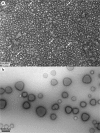Folding, assembly, and aggregation of recombinant murine amelogenins with T21I and P41T point mutations
- PMID: 21540557
- PMCID: PMC3178092
- DOI: 10.1159/000324342
Folding, assembly, and aggregation of recombinant murine amelogenins with T21I and P41T point mutations
Abstract
Two point mutations (T21I and P40T) within amelogenin have been identified from human DNA sequences in 2 instances of amelogenesis imperfecta. We studied the folding and self-assembly of recombinant amelogenin (rM180) compared to the T21I and P40T mutants analogs. At pH 5.8 and 25°C, rM180 and the P41T mutant existed as monomers, whereas the T21I mutant formed small oligomers. At pH 8 and 25°C, all of the amelogenin samples formed nanospheres with hydrodynamic radii (R(H)) of around 15-16 nm. Upon heating to 37°C, particles of P41T increased in size (R(H) = 18 nm). During thermal denaturation at pH 5.8, both of the mutant proteins refolded more slowly than the wild-type (WT) rM180. Variable temperature tryptophan fluorescence and dynamic light scattering studies showed that the WT transformed to a partially folded conformation upon heating and remained stable. Thermal denaturation and refolding studies indicated that the mutants were less stable and exhibit a greater ability to prematurely aggregate compared to the WT. Our data suggest that in the case of P41T, alterations in the self-assembly of amelogenin are a consequence of destabilization of the secondary structure, while in the case of T21I they are a consequence of change in the overall hydrophobicity at the N-terminal region. We propose that alterations in the assembly (i.e. premature aggregation) of mutant amelogenins may have a profound effect on intra- and extracellular processes such as amelogenin secretion, proteolysis, and its interactions with nonamelogenins as well as with the forming mineral.
Copyright © 2011 S. Karger AG, Basel.
Figures



Similar articles
-
Perturbed amelogenin secondary structure leads to uncontrolled aggregation in amelogenesis imperfecta mutant proteins.J Biol Chem. 2010 Dec 24;285(52):40593-603. doi: 10.1074/jbc.M110.131136. Epub 2010 Oct 7. J Biol Chem. 2010. PMID: 20929860 Free PMC article.
-
Dissecting amelogenin protein nanospheres: characterization of metastable oligomers.J Biol Chem. 2011 Oct 7;286(40):34643-53. doi: 10.1074/jbc.M111.250928. Epub 2011 Aug 12. J Biol Chem. 2011. PMID: 21840988 Free PMC article.
-
Self-assembly properties of recombinant engineered amelogenin proteins analyzed by dynamic light scattering and atomic force microscopy.J Struct Biol. 2000 Jul;131(1):27-37. doi: 10.1006/jsbi.2000.4237. J Struct Biol. 2000. PMID: 10945967
-
Random mutagenesis of amelogenin for engineering protein nanoparticles.Biotechnol Bioeng. 2015 Jul;112(7):1319-26. doi: 10.1002/bit.25556. Epub 2015 Feb 20. Biotechnol Bioeng. 2015. PMID: 25664685
-
A Review of the Role of Amelogenin Protein in Enamel Formation and Novel Experimental Techniques to Study its Function.Protein Pept Lett. 2019;26(12):880-886. doi: 10.2174/0929866526666190731120018. Protein Pept Lett. 2019. PMID: 31364509 Review.
Cited by
-
Controls of nature: Secondary, tertiary, and quaternary structure of the enamel protein amelogenin in solution and on hydroxyapatite.J Struct Biol. 2020 Dec 1;212(3):107630. doi: 10.1016/j.jsb.2020.107630. Epub 2020 Sep 24. J Struct Biol. 2020. PMID: 32979496 Free PMC article. Review.
-
Bioactive nanofibers enable the identification of thrombospondin 2 as a key player in enamel regeneration.Biomaterials. 2015 Aug;61:216-28. doi: 10.1016/j.biomaterials.2015.05.035. Epub 2015 May 19. Biomaterials. 2015. PMID: 26004236 Free PMC article.
-
Structural adaptation of tooth enamel protein amelogenin in the presence of SDS micelles.Biopolymers. 2014 May;101(5):525-35. doi: 10.1002/bip.22415. Biopolymers. 2014. PMID: 24114119 Free PMC article.
-
A solution NMR investigation into the impaired self-assembly properties of two murine amelogenins containing the point mutations T21→I or P41→T.Arch Biochem Biophys. 2013 Sep 15;537(2):217-24. doi: 10.1016/j.abb.2013.07.015. Epub 2013 Jul 26. Arch Biochem Biophys. 2013. PMID: 23896516 Free PMC article.
-
Highly acidic pH facilitates enamel protein self-assembly, apatite crystal growth and enamel protein interactions in the early enamel matrix.Front Physiol. 2022 Dec 8;13:1019364. doi: 10.3389/fphys.2022.1019364. eCollection 2022. Front Physiol. 2022. PMID: 36569763 Free PMC article.
References
-
- Barron M.J., Brookes S.J., Kirkham J., Shore R.C., Hunt C., Mironov A., Kingswell N.J., Maycock J., Shuttleworth C.A., Dixon M.J. A mutation in the mouse Amelx tri-tyrosyl domain results in impaired secretion of amelogenin and phenocopies human X-linked amelogenesis imperfecta. Hum Mol Genet. 2010;19:1230–1247. - PMC - PubMed
-
- Collier P.M., Sauk J.J., Rosenbloom J., Yuan Z.A., Gibson C.W. An amelogenin gene defect associated with human X-linked amelogenesis imperfecta. Arch Oral Biol. 1997;42:235–242. - PubMed
-
- Fincham A.G., Sarte J. Moradianoldak. P.E. Mass-spectrographic analysis of a porcine amelogenin identifies a single phosphorylated locus. Calcif Tissue Int. 1994;55:398–400. - PubMed
-
- Lench N.J., Winter G.B. Characterization Of molecular defects in X-Linked amelogenesis imperfecta (Aih1) Hum Mutat. 1995;5:251–259. - PubMed

